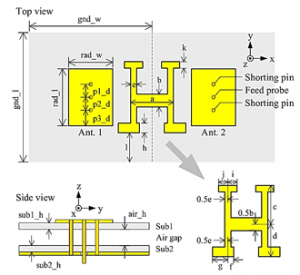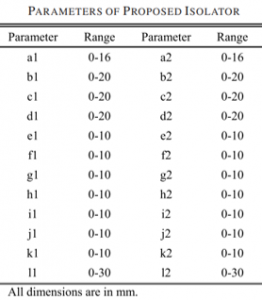Frequency Reconfigurable Antenna Array with Isolator for ISM and WiMAX Bands
Problem Description
Design Challenges
The design and implementation of the frequency reconfigurable array with isolator is very challenging mainly due to the following reasons:
- Strong mutual coupling between the antenna elements which effectively reduces the performance of the multiple antenna system (i.e., the array).
- Topology of proposed parasitic element (isolator) for mutual coupling reduction not previously known (i.e., no initial design).
- Frequency reconfigurability over ISM band (resonance frequency of 2.4 GHz) and WiMAX band (resonance frequency of 3.5 GHz).
- Dual-mode antenna operations (in terms of resonance frequency) to be implemented via aperture coupling technology (i.e., use of varying substrate thickness to reconfigure the equivalent permittivity of the aperture coupled antenna element).
AI-driven Design with SADEA-III
Optimization Problem
For the given frequency reconfigurable antenna array with isolator, the specifications set as the optimization goals for dual-mode operations are as follows:
- State or Mode 1 (ISM Band and Resonance Frequency of 2.4 GHz): Thickness of inserted substrate which controls the equivalent permittivity of the aperture coupled antenna element is 2.4 mm.
- Maximum reflection coefficient (S11) < -10 dB (2.4 GHz to 2.54 GHz)
- Maximum transmission coefficient (S12) < -20 dB (2.4 GHz to 2.54 GHz)
- State or Mode 2 (WiMAX Band and Resonance Frequency of 3.4 GHz): Thickness of inserted substrate which controls the equivalent permittivity of the aperture coupled antenna element is 1.2 mm.
- Maximum reflection coefficient (S11) < -10 dB (3.28 GHz to 3.4 GHz)
- Maximum transmission coefficient (S12) < -20 dB (3.28 GHz to 3.4 GHz)
Layout of the Frequency Reconfigurable Antenna with Parasitic Element (Isolator)

Synthesis and Measurement Results
The design obtained by the SADEA-III is verified through a physical implementation.


For this case:
- The synthesized antenna by the latest SADEA-III obtains the following results after about two weeks’ optimization.
- State or Mode 1 (ISM Band and Resonance Frequency of 2.4 GHz): Thickness of inserted substrate which controls the equivalent permittivity of the aperture coupled antenna element is 2.4 mm.
- Maximum reflection coefficient (S11) = -10 dB (2.4 GHz to 2.54 GHz)
- Maximum transmission coefficient (S12) = -20.3 dB (2.4 GHz to 2.54 GHz)
- State or Mode 2 (WiMAX Band and Resonance Frequency of 3.4 GHz): Thickness of inserted substrate which controls the equivalent permittivity of the aperture coupled antenna element is 1.2 mm.
- Maximum reflection coefficient (S11) = -10 dB (3.28 GHz to 3.4 GHz)
- Maximum transmission coefficient (S12) = -21.3 dB (3.28 GHz to 3.4 GHz)
- State or Mode 1 (ISM Band and Resonance Frequency of 2.4 GHz): Thickness of inserted substrate which controls the equivalent permittivity of the aperture coupled antenna element is 2.4 mm.
- The measurement results are in close agreement with the simulation results.
